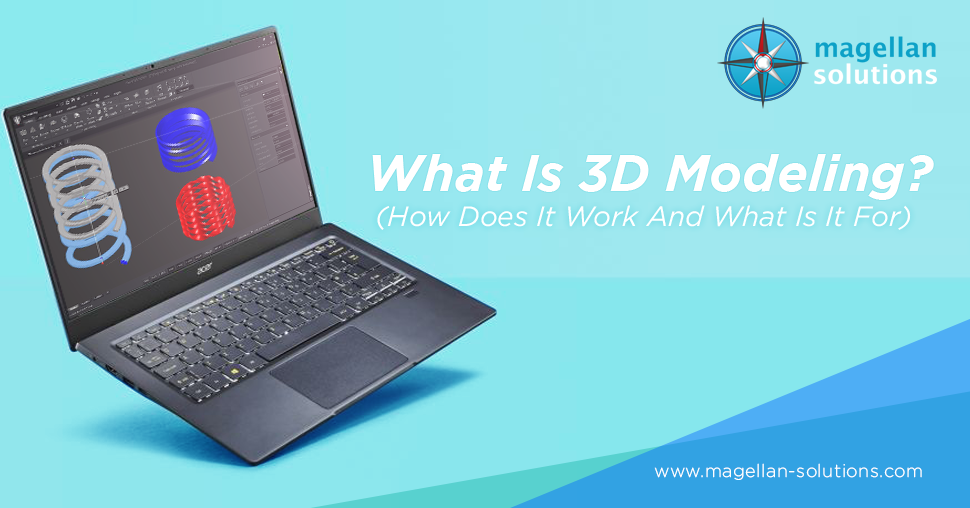Schedule a FREE call with our outsourcing expert now and get a precise quotation that meets your requirements. Don't wait - get started today!
Technology has come a long way in the past few years, allowing many ideas previously thought impossible to come to life.
Art and design are constantly evolving, and thanks to recent technological innovations, more concepts are now feasible, changing the landscape in engineering, architecture, product design, and more.
While 3D technology has been around for quite some time, it had to spend many years in research and development to be applied thoroughly.
3D modeling is a fine example of the application of 3D technology, and there are many reasons why it’s conquering design, and for a good reason.
What is 3D Modelling?
It manipulates points in a virtual space to form a mesh: the essential foundation for creating a surface. 3D modelers typically use geometric primitives like cylinders, cubes, and spheres to start the 3D modeling process. Using this basic shape, they work until they develop a complex and precise 3D digital representation of an object.
There are different techniques employed in 3D modeling. Some prominent examples include polygon modeling, 3D sculpting, 3D scanning, spline modeling, and procedural modeling. A 3D modeler can use any of these techniques depending on the nature and goal of the project.
In simpler words, 3D modeling results from creating digital objects with volume. This is where the usual process of producing objects — appliances, devices, buildings, and many more — usually begins. A specialized 3D modeling software is programmed to compute the specifications of an object, making the entire process more efficient and fast compared to 2D drawings.
Because of its versatility, many industries use it to produce or enhance their final products.
The Applications of 3D Modeling
Now that 3D modeling proves to be a valuable tool in many industries and interests, it’s time to take a look at the scope of its benefits.
3D modeling has various applications.
Architecture and Engineering
- Interactive renderings of infrastructure
- Construction
- Site Layout
- Machine control
- Effective planning and designing
- Proper documentation
- Quality deliverables
Entertainment
- Creation of CGI characters
- Application of special effects
- Speeds up production
- Stage design
Video Game
- Interactive visual 3D component
- Realistic characters
Marketing and Commercial Advertising
- Better product pitches
- Interactive 3D tours in the real estate sector
- Product design
- Better visualization of event program and set-up
- Graphical representation of brand activations
The other applications of 3D models are:
- Medical field (representation of human anatomy or medical devices)
- Fashion design
- Multimedia design
- Academic research
3D BIM Modeling
Building information modeling (BIM) creates digital 3D models of buildings and infrastructure. It contains graphical and non-graphical information that helps improve design, engineering, and building data accuracy. Using BIM enhances collaboration and productivity through the complete flow of information it provides across different project teams.
3D BIM modeling is mainly used in architecture, construction, engineering, and mechanical industries.
Some of the famous structures that used 3D BIM modeling are Crossrail at Tottenham Court Road (Europe), Istanbul New Airport (Turkey), and Baku National Stadium (Azerbaijan).
3D CAD Modeling
3D CAD modeling is famous for architects, designers, engineers, game developers, and manufacturers. It involves using computer-aided design (CAD) software to create a virtual reality object with the same properties as the physical object. This virtual model shows how the product would look and behave once produced in the real world. Moreover, it allows 3D professionals to evaluate the project’s rigidity, quality, or structural integrity when introduced to different environmental factors.
Because of the comprehensive information it provides during the product development and design process, almost all industries use 3D CAD modeling.
Its design process has five main phases: conceptualization, visualization, analysis, manufacturing, and management.
The conceptualization phase allows designers to edit designs as quickly as possible whenever modifications are needed. It shows history-based management’s dimensions, features, and other valuable details.
Meanwhile, the visualization phase allows designers, key decision-makers, and even customers to view designs from every angle and scale. Designers can produce photorealistic renders if it’s used as a marketing tool. It works well in selling units in the real estate industry, especially when buildings are not yet available.
The analysis phase is for checking the design against its intended requirements. Advanced CAD software can test visual prototypes through simulation. This process analyzes how the model will react when exposed to heat, collisions, vibrations, loads, and other environmental factors. For instance, testing a rice cooker against all possible elements will let the manufacturer know its resistance to heat.
Using a 3D CAD model is the best way to produce a product for the manufacturing phase. A cheap and fast way to manufacture a product is through 3D printing. 3D models or 3D-scanned objects are prerequisites in 3D printing. Without it, it is impossible to produce anything.
Lastly, the role of 3D CAD models in the management phase is to store all data for documentation purposes. It also facilitates easy data transfer and communication among stakeholders.
3D Modeling for Earthwork
3D modeling for earthwork requires a steeper learning curve than most 3D modeling applications. It considers the landscape’s natural terrain and other physical restrictions when building infrastructures. Architects and engineers can construct a safe and durable structure by determining the earth’s composition.
Earthwork modeling is usually the first step of engineers and architects when building infrastructures. Its real-life applications include building dams, railway beds, causeways, levees, and canals.
3D Modeling and Animation
3D animation gives more life to characters and objects in movies, TV series, and commercials. It improves viewer experience and obtains higher engagement.
However, its application isn’t limited to the entertainment industry. It is also widely used in game development, marketing, web, and multimedia industries.
3D modeling and animation are also utilized to improve business efficiency and facilitate better customer communication. Since it’s digital, modifying designs only takes a few clicks. Animated 3D models also make it easier to present complex ideas since it depicts an accurate representation of reality.
If you still can’t grasp the idea of 3D animation, try to think of the latest Disney Animation or Pixar film you’ve watched. Frozen, Moana, and Coco are some top-rated movies that incorporate 3D modeling to create the characters you’ve come to love.
3D Modeling and Rendering
While 3D modeling is the creation of three-dimensional objects in a virtual space, 3D rendering turns those 3D models into 2D images. Both of these processes are part of the entire 3D work process.
After producing the 3D model, items (such as bricks, trees, and people) and proper lighting are applied to the image to create an interactive scene. Rendering the image can take a few minutes or several hours, depending on the complexity and quality of the picture.
3D rendering allows a convenient way to demonstrate the original design idea of exhibitions and conferences. It is also used in printed promotional ads, architecture, scientific projects, video creation, and e-commerce stores.
3D Modeling and Scanning
3D scanning is the process of capturing a physical object’s actual shape and features and transforming it into a digital copy. Using advanced methods like 3D laser scanning, structured light scanning, and photogrammetry, 3D designers can produce precise images that require minimal modifications and furnishings.
Unlike 3D modeling, designers need not start a design from scratch. They can edit the file for final touches and other additional designs.
3D Modeling and 3D Printing
3D printing refers to producing a physical three-dimensional object from a digital model. It is nearly impossible to produce it without a 3D or CAD model. Compared to traditional manufacturing methods, it uses fewer materials.
The 3D printing industry continues to grow as 3D printers become more sophisticated. From printing spare parts and bobbleheads, 3D printing is now used for advanced functions such as 3D printing of body parts and even body organs.
3D Modeling Software
A quick Google search can show you the vast selection of 3D modeling software you can use to start your project. Here are some examples:
For architecture:
- SketchUp
- ArchiCAD
- Revit
- AutoCAD Civil 3D
- Solidworks
- Rhino3D
- 3D Studio Max
For video games/animation:
- Autodesk Maya
- ZBrush
- Cinema 4D
- Blender
- Autodesk 3ds Max
For 3D Printing
- TinkerCAD
- SketchUp
- Blender
Outsource Top Quality 3D Modeling for Less
Save up on time and expenses without compromising quality. Outsourcing allows you to save costs, hire world-class 3D designers, get access to unavailable resources, and achieve faster turnaround times.
Especially beneficial in short-term projects, outsourcing 3D modeling services provides flexibility that enables you to scale up or down depending on your business needs. You can also use it if your internal team needs support due to growing projects in your firm.
Instead of hiring new staff with more considerable hiring and operational costs, outsource to an offshore location like the Philippines. Save up on expenses and enjoy more time to focus on your core business.
Read this FREE guide to learn more about 3D modeling outsourcing and what it can do for you.
Interested in outsourcing your 3D model works? Contact us now!
















